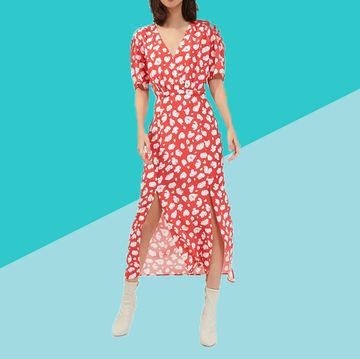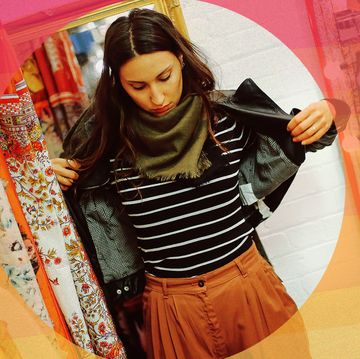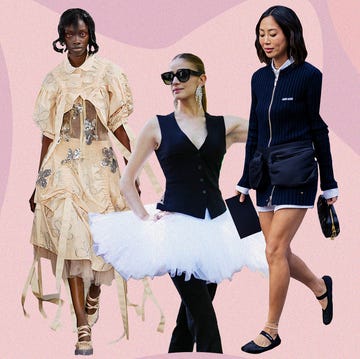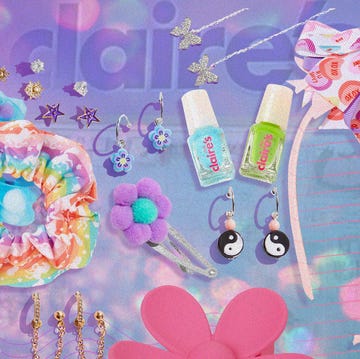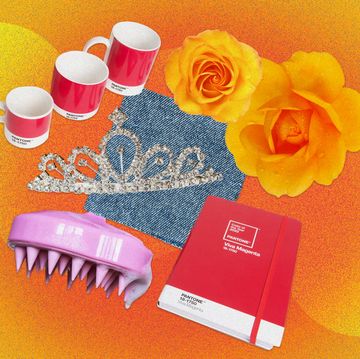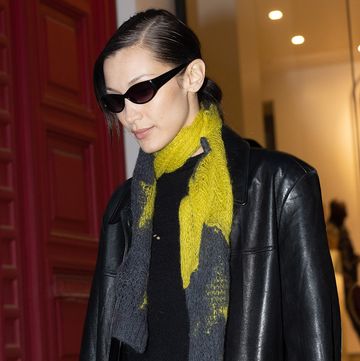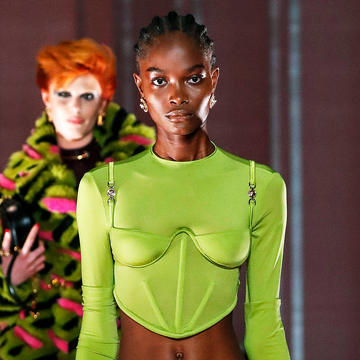An item of clothing should be for every body, regardless of someone’s gender or sexual identity. That’s the idea behind Urbody, a functional fashion line designed to celebrate acceptance, self-love, and gender freedom. The brand is the vision of Mere Abrams, a nonbinary social worker and gender researcher, and her best friend, Anna Graham, a longtime executive in the fashion world.
The duo created their clothing to challenge the mainstream fashion industry to think beyond the rules it has followed for centuries — for instance, why should a company be the one to dictate who should and should not wear a dress? And why is a specific garment labeled “masculine” or “feminine” instead of being open to anyone who identifies with wanting to wear it?
This is especially an issue in the undergarment world, which Abrams knows firsthand after years of frustration over searching for the right underwear to fit their body — and feeling intimidated by the shopping experience in itself, with items bluntly filed into sections labeled “men” or “women.” To fix this problem, the friends set out to fill a very deep void within the fashion world.
Shondaland caught up with the Urbody founders to hear more about the vision behind their brand and their challenge to the big fashion brands of the world.
NICOLE PAJER: What inspired Urbody?
MERE ABRAMS: The name came about two years ago, but the real genesis started when Anna and I became close friends in college. I was going through my own process of figuring out my gender and identity and self-expression that felt right for me. Anna was a huge support in the process. And throughout those years of navigating gender, I found that there were really not that many options in terms of clothing, particularly undergarments and bodywear for my body, that authentically expressed who I was and affirmed my identity. So, I came to Anna about this. She saw firsthand the fact that this community of queer and trans and nonbinary and gender-nonconforming folks had really been overwhelmed.
ANNA GRAHAM: I was born and raised in the fashion business. And I always felt like the brands that surrounded me didn’t always cater to me and my size. I always felt this pressure to fit into these industry standards that didn’t necessarily fit me. Although we were coming from different views on that, Mere and I felt [unseen]. I always knew if and when I worked to create my own fashion brand, it would really be something that pushed the industry forward, creating something for all body types, all types of beauty, and now all types of genders. I realized that Mere had such limited options. And then I looked around, and, even as the person that didn’t necessarily always fit in, I did have options. And so I knew that we had an opportunity to create something really special and create a brand that was designed for human beings that saw all genders.
MA: We felt a need to create a collection of garments that presented options to folks across the gender spectrum, as well as create a call to action for the fashion industry to realize its role in trans lives and trans liberation. We’ve seen huge strides in medicine and mental health and other sectors around supporting trans folks, and I think fashion has a really big role to play. So we really wanted to cater to the needs of this community. We did a ton of research within the community, hearing about where current underwear options missed the mark. The products we launched with are infused with that feedback. We really hope the major mainstream underwear brands of the world will consider different body parts and different body sizes and what the person who wears their garments looks like.
NP: What sets the brand apart from others that are making trans and nonbinary clothing?
AG: Our brand is timeless and classic. I think that a lot of brands out there have their own aesthetic, and it may be a little bit more kitschy, and we really went for high-quality garments that had an elevated yet functional aesthetic to them that were core products. We took into account comfort and creating something that doesn’t necessarily scream one community or the other. We’re not going to assume what works for somebody. We want them to come to the brand and enjoy that experience based on the aesthetic and the quality that we provide.
MA: Putting on clothing that isn’t made for your body can elicit a feeling of gender dysphoria. We wanted to create garments that people put on their bodies that facilitated a moment of gender euphoria, of them feeling even better about their bodies because the garment feels like it was made for them. In the product-development process, we started from scratch. We said what the fashion industry has done previously, as far as binary standards around grading and sizing, isn’t going to work for us. So, we need to create a new template and move from there.
NP: So many people take being able to buy a pair of underwear for granted. Mere, walk us through your experience of finding limited options in mainstream stores.
MA: The experience is really frustrating. I remember buying my first pair of what some people would call masculine underwear. It’s that thicker waistband, more the brief style. And I remember walking into a department store and being so nervous about even just picking up this underwear because it was in a section titled “men” — all the people walking around the section didn’t necessarily look like me. And here I was just wanting to find a piece of underwear that helped me feel better about myself and who I am. And so, even just the experience of shopping was uncomfortable.
Once I took the underwear home, there were aspects that felt like, “Wow. This makes me feel good about who I am.” I always admired the thick band because, to me, that really communicated this sense of masculinity. And I would look at the underwear and say, “This is amazing.” And so there was this moment I was hoping would be euphoric. But once the garment was put on my body, it really made me feel like, “Is there something about my body that’s wrong? Because it’s not quite fitting in this garment in the way that it should. And I’m more aware of my hips and my butt now than I was even before I put it on.” And so, those are the types of experiences that illustrate how gender dysphoria and moments where we’re aware of our gender and how that does or doesn’t fit in, or how is it different, come up every day.
NP: Tell us about the models for your company.
AG: Our models are everyday people. Most of them have never modeled before. We interviewed them and really wanted to understand their story, and why they felt our vision and mission were important, and infused that into our brand. We think it’s really the stories and the experiences behind our brand that are going to differentiate us from other brands.
MA: It was important for us to feel like we had representation across the gender spectrum. Oftentimes when you see trans folks on the covers of magazines, it’s one trans person, and that person is supposed to represent the community. In building Urbody, we really got to see the amazing diversity of genders and personalities and skills and talents and interests that exists within our community. And we really wanted to highlight that.
NP: What has the reaction been to your garments?
MA: Seeing the models try on the garments and their reactions to them was amazing.
AG: I’ve been in so many different fit sessions, but I’ve never experienced how emotional it could be for somebody to try on something and feel so affirmed in their gender and their identity. There was so much joy that it brought to them, knowing there was something that was made for them and made them feel comfortable. And they were able to go about their day just how I go about my day, but I take it for granted when I buy underwear.
MA: We have had people writing in, saying, “Thank you so much for creating what you did. Now I have something that is more [healthful] to wear instead of my commercial chest binder.” We gave someone a pair of packing boxers. After trying them on, they said, “I want one for every day of the week!” We recently connected with a trans queer personal trainer who said our leggings were the first legging they can wear at the gym while working out because other legging options were too revealing. So, we’ve really gotten great feedback. It’s not just like, “Oh, this is a great T-shirt. It looks good.” It changes how people feel. And that is what we’re most proud of.
NP: What else is coming up for the brand?
MA: We see a lot of opportunity as far as inclusive sizing. And that goes in both directions, with larger bodies and smaller bodies, even including youth. We’ve seen the legislative attacks happening on trans youth, and the fashion industry really needs to step up in giving youth more tools for gender affirmation and opportunities to feel seen and celebrated. And so that’s also an exciting area that we are already in development on.
We want to become [a brand that] other brands look to and say, “We really want to do want gender-inclusive fashion. What does it look like?” And so we will be releasing new products to really show what it looks like to take a certain shape and fit it on different body types. We’re excited to showcase that top-to-bottom inclusivity for other brands to hopefully follow because I think brands are paying attention to inclusivity. What we really want to do is to push them to look at inclusivity at every level, not just necessarily who they’re covering on Pride Month or who they’re putting on the cover of their magazines.
NP: Where can people buy Urbody?
AG: Direct to the consumer through the website. We’re not quite ready to be in the wholesale space, and I don’t know if the wholesale space is ready for us yet, unfortunately. But we are definitely looking to open up down the line and would like to have our own retail stores.
Nicole is a freelance writer published in The New York Times, AARP, Woman’s Day, Parade, Men’s Journal, Wired, Emmy Magazine, and more. Keep up with her adventures on Twitter at @nicolepajer.
Get Shondaland directly in your inbox: SUBSCRIBE TODAY




